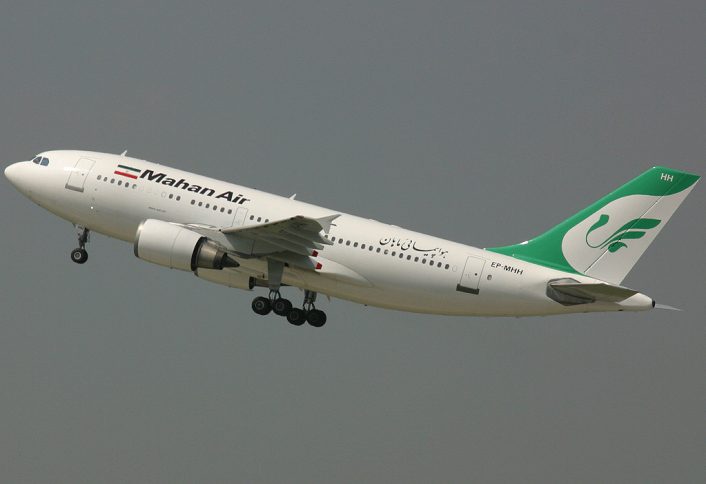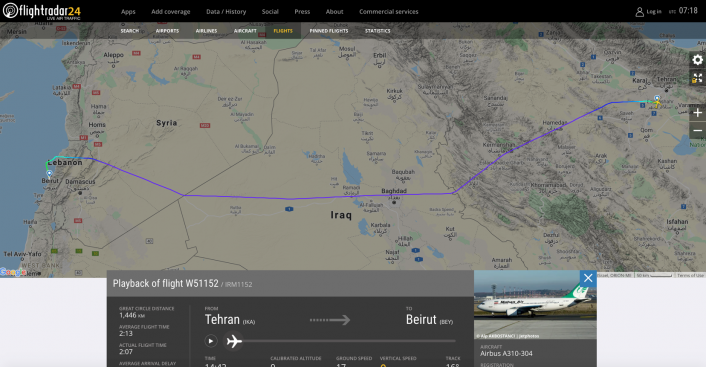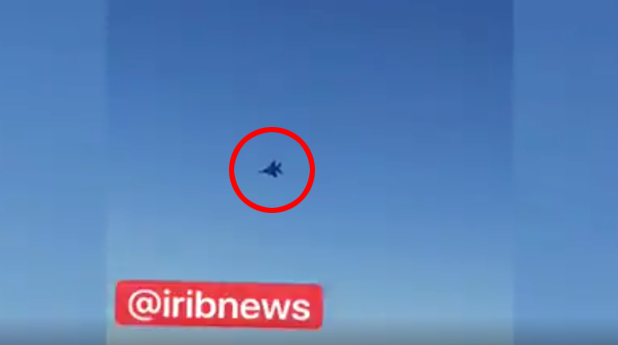Some Iranian Mahan Air Passengers Sustained Injuries as Airliner Maneuvered During Intercept.
U.S. Central Command has confirmed that a U.S. Air Force F-15C Eagle performed a visual daytime intercept and inspection of an Iranian Mahan Air A310 passenger airliner flying as IRM1152 from Tehran, Iran, to Beirut, Lebanon, over Syrian airspace in fair weather conditions. The F-15 maintained a horizontal separation of over 3,000 feet (about 1,000 meters) during the intercept according to statements from U.S. Central Command. Video taken from the Iranian airliner later released by the Iranian State TV shows the moment the two jets approached the A310. Initially, the two F-15s were mistakely reported as being Israeli Air Force fighters.
Watch: Video relarased by #Iran StateTV purportedly shows the moment 2 #Israeli warplanes threaten #Iranian passenger plane in the #Syrian airspace. pic.twitter.com/982gEyQb2h
— Habib Abdolhossein (@HAbdolhossein) July 23, 2020
While standards for minimum separation distance of aircraft in flight vary with altitude, weather and regional air traffic requirements, the distance maintained by the U.S. F-15 is generally within accepted safety standards for military aircraft performing a visual security intercept in fair weather.

Iranian news media did show passenger video of what appeared to be the airliner maneuvering during the encounter as passengers screamed. Additional video showed one man with bleeding injuries to his nose and forehead. A report from Beirut, Lebanon, where the Iranian airliner landed, said that injuries sustained by passengers were minor.

According to Flightradar24.com data, the A310 made a climb followed by a quick descent: that must be the moment when the F-15s approached the airliner to perform their VID (Visual Identification). Based on the video and reports, it looks like the Iranian Mahan Air pilot performed a sort of avoidance maneuver when he saw the fighters or had a warning from the TCAS (Traffic Collidance Avoidance System).
Granular data from 16:10 to 16:20 UTC from IRM1152. A climb from 34,000 to 34,600 feet between 16:13:53 and 16:14:32, then descent back to 34,000 feet by 16:15:29. pic.twitter.com/dQSpPvB4vV
— Flightradar24 (@flightradar24) July 23, 2020
Generally speaking, the interception of a civil aircraft is performed in accordance with the special recommendations of ICAO (International Civil Aviation Organization) RAC (Rules of the Air) Appendix 2 and subsequent Attachments. ICAO recommends all the parties (ATC, pilots of both the interceptor and civilian aircraft) to be made aware of the actions that are being undertaken. In the case of IRM1152 flight, it’s not clear whether the civialin ATC control was informed of the intercept (depending on the airspace where the VID takes place, the civilian ATC agency is informed by its military counterpart – where direct communication links exist – of the intercept so that the civilian pilot is warned and prepared to the sight of two combat aircraft approaching it) or the Eagle pilots made an attempt to contact the airliner on the international emergency VHF frequency 121.500 Mhz.
Anyway, here are some other interesting guidelines provided by ICAO to keep in mind when analysing such intercepts:
A standard method should be established for the manoeuvring of aircraft intercepting a civil aircraft in order to avoid any hazard for the intercepted aircraft. Such method should take due account of the performance limitations of civil aircraft, the need to avoid flying in such proximity to the intercepted aircraft that a collision hazard may be created and the need to avoid crossing the aircraft’s flight path or to perform any other manoeuvre in such a manner that the wake turbulence may be hazardous, particularly if the intercepted aircraft is a light aircraft
An aircraft equipped with an airborne collision avoidance system (ACAS), which is being intercepted, may perceive the interceptor as a collision threat and thus initiate an avoidance manoeuvre in response to an ACAS resolution advisory. Such a manoeuvre might be misinterpreted by the interceptor as an indication of unfriendly intentions. It is important,therefore, that pilots of intercepting aircraft equipped with asecondary surveillance radar (SSR) transponder suppress the transmission of pressure-altitude information (in Mode C replies or in the AC field of Mode S replies) within a range ofat least 37 km (20 NM) of the aircraft being intercepted. This prevents the ACAS in the intercepted aircraft from using resolution advisories in respect of the interceptor, while the ACAS traffic advisory information will remain available
Dealing with the intercept procedure:
Phase I
The intercepting aircraft should approach the intercepted aircraft from astern. The element leader, or the single intercepting aircraft, should normally take up a position on the left (port)side, slightly above and ahead of the intercepted aircraft, within the field of view of the pilot of the intercepted aircraft, and initially not closer to the aircraft than 300 m. Any other participating aircraft should stay well clear of the intercepted aircraft, preferably above and behind. After speed and position have been established, the aircraft should, if necessary, proceed with Phase II of the procedure.
Phase II
The element leader, or the single intercepting aircraft, should begin closing in gently on the intercepted aircraft, at the same level, until no closer than absolutely necessary to obtain the information needed. The element leader, or the single intercepting aircraft, should use caution to avoid startling the flightcrew or the passengers of the intercepted aircraft, keeping constantly in mind the fact that manoeuvres considered normal to an intercepting aircraft may be considered hazardous to passengers and crews of civil aircraft. Any other participating aircraft should continue to stay well clear of the intercepted aircraft. Upon completion of identification, the intercepting aircraft should withdraw from the vicinity of the intercepted aircraft as outlined in Phase III.
Phase III
The element leader, or the single intercepting aircraft, should break gently away from the intercepted aircraft in a shallowdive. Any other participating aircraft should stay well clear ofthe intercepted aircraft and rejoin their leader.
U.S. Central Command spokesman Capt. Bill Urban said that the U.S. F-15 performed a visual inspection of the Iranian airliner as it passed within the vicinity of a U.S. air base in Syria. Capt. Urban said that the F-15 was on a “routine air mission” near an American military base in the region and that the aircraft had flown a, “Standard visual inspection of a Mahan Air passenger airliner to ensure the safety of coalition personnel at al-Tanf garrison”. Capt. Urban went on to say that, when the F-15 Eagle made positive identification of the Mahan Air airliner, the USAF pilot responding, “safely opened distance” between his aircraft and the airliner. Capt. Urban also said, “The professional intercept was conducted in accordance with international standards”.
This seems to be the moment Mahan Air 1152 from Tehran > Beirut met the mysterious fighter jet and rapidly changed alt.
Was @ 34000 ft entering Syria 16:13:49 – (over Al-Tanf U.S. mil base)
then dropped 125 feet, and immd climbed 500 ft – all in 15 sec.
b4 resettling at 34025 ft https://t.co/4ElMbXNMl7 pic.twitter.com/LTe1I3OPZo
— avi scharf (@avischarf) July 23, 2020
As for the reasons for the intercept, it would be interesting to know if something suspect was reported (maybe based on U.S. intelligence) or if the route the aircraft followed brought it closer to al-Tanf base than expected.
Tensions between U.S. forces and Iran in the region have remained high since Iranian Gen. Qassim Soleimani was killed in a U.S. remotely piloted aircraft strike in Iraq on January 3, 2020. During a subsequent incident on January 7 in Kerman, Iran, 56 mourners of Gen. Qassim Soleimani were trampled to death and 212 more were injured at a memorial service.
On Jan. 8, 2020, Iranian forces launched a retaliatory missile strike at two U.S. bases in Iraq. No U.S. personnel died in the attacks but nearly 100 persons were reported as having head injuries, possibly from the concussion of missile warheads on impact.
Iran and the U.S. have since maintained rhetoric condemning the actions of the other as tensions in the region remain high.









